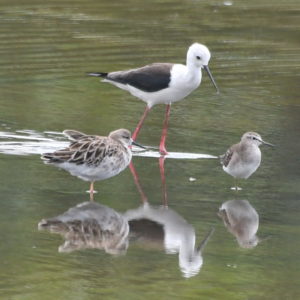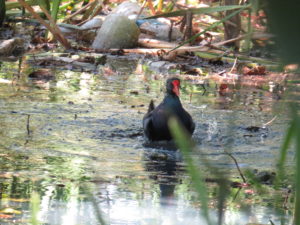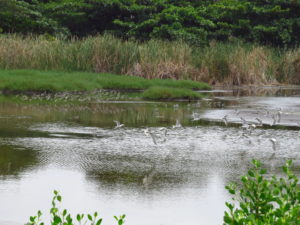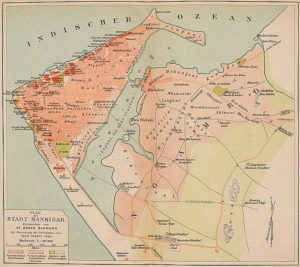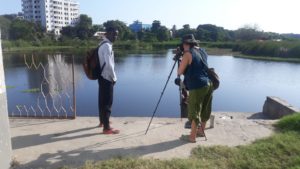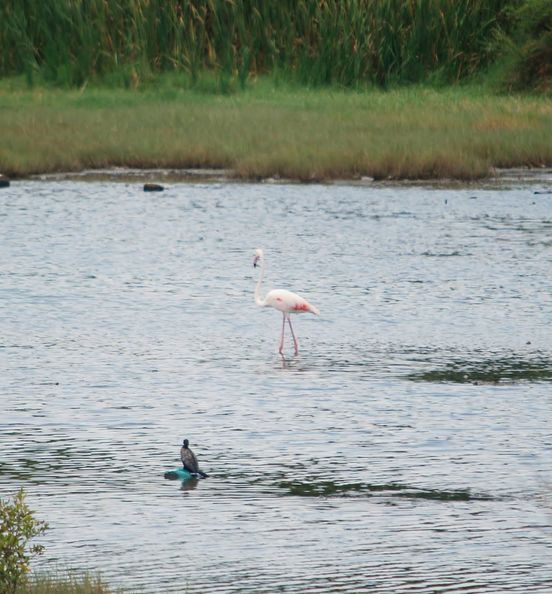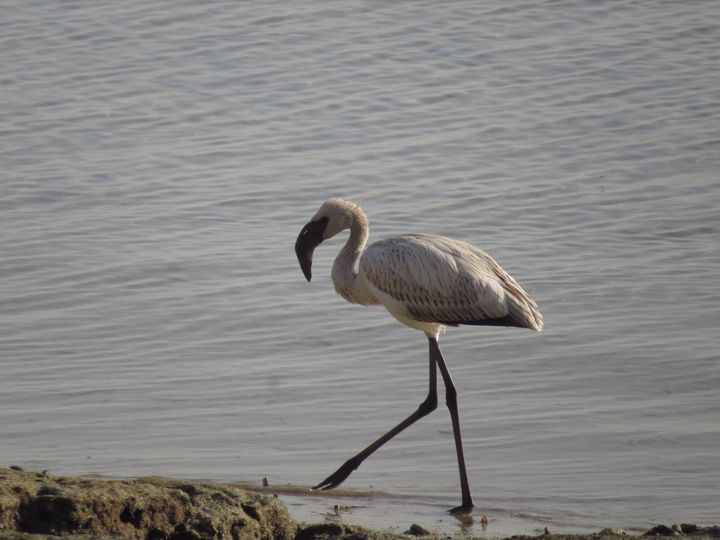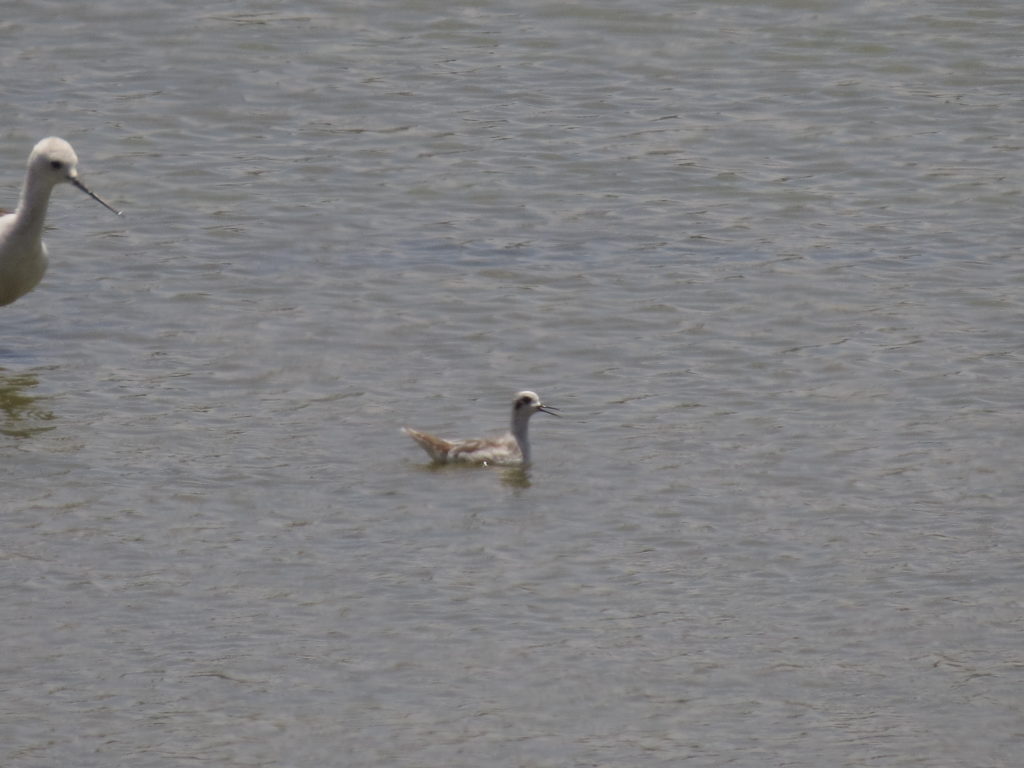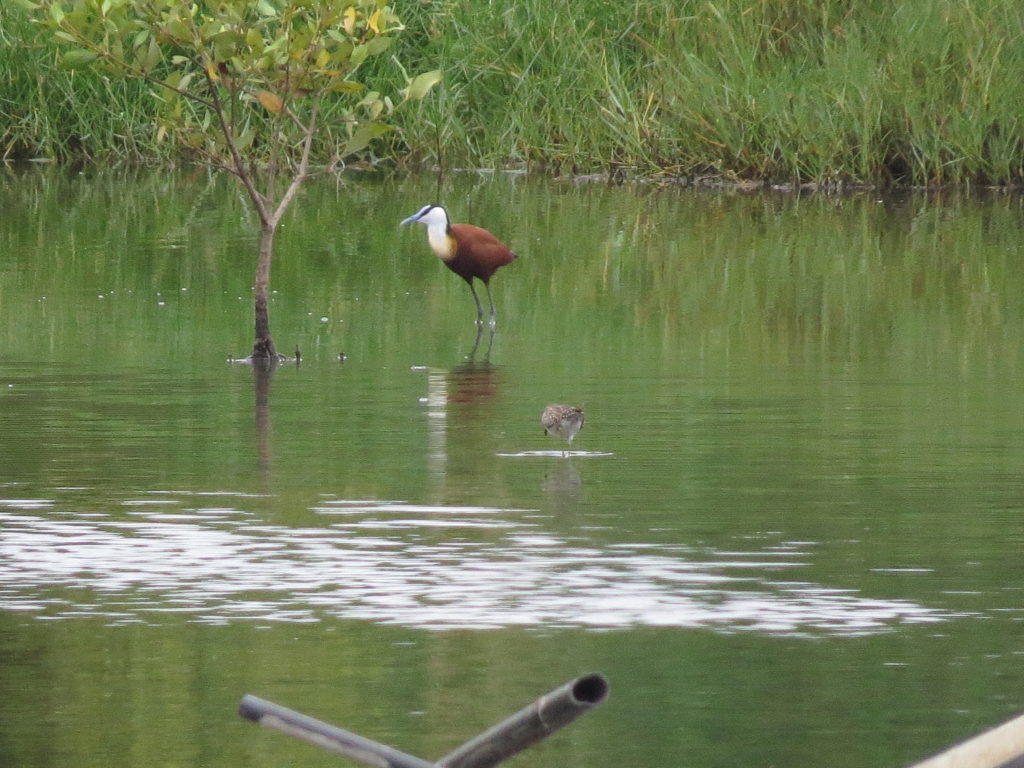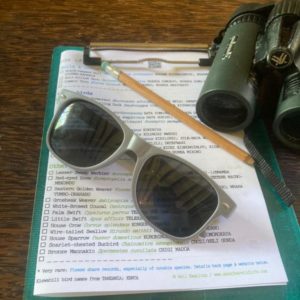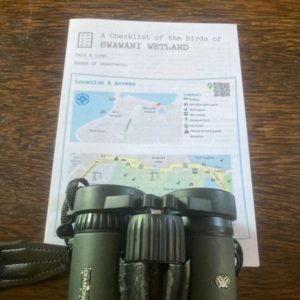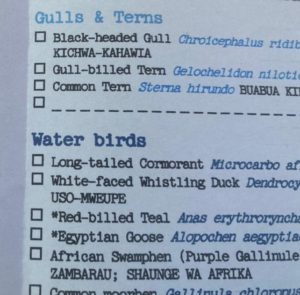HOTSPOT
BWAWANI WETLAND:
WATER-BIRD WONDERLAND
Just north of Stone Town lies one of wild Zanzibar’s best kept secrets: Bwawani Wetland – arguably one of our most important wildlife hotspots. Virtually unknown, despite being in Town, these ponds host water-birds in spectacular number and variety. Many of Zanzibar’s recorded bird species are known only from Bwawani: this world-class water-bird refuge is a must-see for any serious birder.
HABITAT
Bwawani Wetland’s network of reed-fringed brackish and freshwater pools is a birder’s delight. There are three main pools; all teem with life, despite a degree of urban pollution.
Surface freshwater is naturally scarce on Zanzibar’s porous coral limestone bedrock; Bwawani’s muddy pools are of critical importance for resident, migratory and wandering water birds, and the surrounding reed beds offer refuge to weavers and warblers.
To the east lies mangrove forest fringing the coast, and to the seaward side of the mangroves are tidal mudflats: feeding grounds for resident and migrant coastal waders and other shore birds.
HIGHLIGHTS
Resident water birds include White-faced Whistling Ducks in great number which, along with numerous Black-winged Stilts, are iconic of the site. Other duck and goose species sometimes join them.
More discreet, yet ever present, are families of Pied Kingfishers and Water Thicknees. Long-tailed Cormorants are reliably spotted – if not fishing or drying their wings, then flying overhead. Look out, too, for elegant African Sacred Ibis.
A variety of heron and egret species stalk in the long grass and pool edges, perhaps even the locally scarce Purple Heron, or the nocturnal Black-Crowned Night-heron which elsewhere (like the Water Thicknee) are usually only heard after dark.
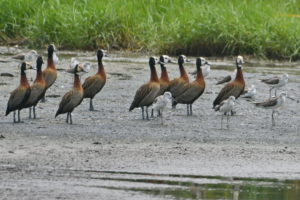
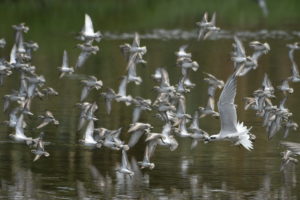
Also hiding in the reeds you can find beautiful African Swamphen (formerly and still colloquially known as Purple Gallinule) and Common Moorhen.
Around the freshwater lake to the East, increasing numbers of birds hide in the reeds: Lesser Swamp Warbler (more often heard than seen), almost-invisible Little Bitterns skulk, and Grosbeak Weavers nest. Wire-tailed Swallows and Little Swifts feast on insects over the water around the Mabluu Mosque which stands over the lake, while Mangrove Kingfishers and Scarlet-Chested Sunbirds call from the mangroves to the east.
The shallower west and central pools are seasonally very important for waders, including many species hard to spot elsewhere in Zanzibar: Little Stints, Sandpipers (e.g. Wood Sandpiper, Curlew Sandpiper, Marsh Sandpiper), and even the occasional Ruff. Gulls (such as Black-headed) and terns (most commonly Gull-billed Terns) join them.
At low tide, don’t miss the tidal mudflats to the northeast for the gamut of waders: Common Greenshank, Common Ringed Plover, Whimbrel, Crab-Plover and many other shore birds. A handy guide to Zanzibar Shore birds is available.
RARITIES
Every time I visit this place, I seem to see a new kind of bird, and it is also a beautiful place to come to relax and contemplate, as you watch birds swimming, feeding and fishing.
SABRY JUMA
Even regular visitors grow accustomed to finding a new species each time they visit. Exciting, one-off sightings have included African Jacana, Black Crake, and African Painted-Snipe. While none of these species can be promised, with sharp eyes you could very well spot something new for the list!
Vagrants encountered elsewhere in Zanzibar have, on more than one occasion, later found refuge here. Five Greater Flamingos seen first in Matemwe spent several subsequent weeks in Bwawani in 2012-13, & the species returned the following year; Red-necked phalarope arrived in Bwawani a week after being spotted in Chwaka and Chukwani in 2018, and a young Lesser Flamingo (seen first in Chukwani in 2020) spent the following few weeks at Bwawani.
Don’t miss it!
POCKET SPECIES CHECKLIST
To help you make the most of a trip to Bwawani, we have curated a checklist and annotated site map.
Download our Pocket Checklist of the Birds of Bwawani Wetland, which includes English, Kiswahili and Scientific bird names and a site map indicating access locations and best viewpoints, for a small donation here.
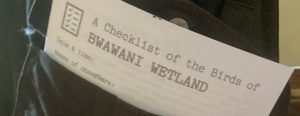
LOCATION & ACCESS
For somewhere so full of life yet little known, Bwawani is remarkably accessible – at the north end of Creek Road in Malindi, Stone Town.
There are two points of access by road. To the Northwest, in front of the Bwawani Hotel (where access is subject to the discretion of the hotel guards) the wall by the car park gives views of the western pool, while the central and eastern pools are accessed from the East via the Mabluu Mosque Road opposite Zanzibar Water Authority (ZAWA) offices. A raised footpath (also accessible on foot from the South) runs North-South between the Central pool and Eastern Freshwater lake, offering great views of both pools. To the east of the access road lies Mangrove forest, and to the north of the mangroves are tidal mudflats home to resident and migrant coastal waders and other shore birds.
NB: Access to the area is subject to change, with construction planned associated with port development and redevelopment of the hotel.
North end of Creek Road, Malindi, Stone Town
CYCLES & RHYTHMS
WHEN TO GO – Bwawani has great birding to offer year-round. But different birds shine at different times of season and tide.
Sept-Mar brings migratory waders, especially at high tide, when the wetland serves as a high-tide roost.
During dry seasons, freshwater such as Bwawani is a scarce and precious resource for water birds. The falling water levels expose more mudflats for foraging and roosting waders.
The rains herald breeding season for many of the resident birds that breed in the reed beds and mangroves, and are more likely to call and court conspicuously any time clouds part.
Early morning visitors can have a better chance of hearing vocalisations and avoid the worst of the the midday heat. However Bwawani remains a rewarding destination during any daylight hours.

What to bring
Drinking Water, sun protection, and bug spray, It’s hot in the sun and buggy in the shade.
You’ll want binoculars or a superzoom camera for the waders.
Bird Book(s), our At-a-Glance Guide to Zanzibar’s Common Shore Birds and our Pocket Checklist of the Birds of Bwawani Wetland.
CAUTION: Beware of thieves! As in all crowded areas, keep all your valuables close to you. The Hotel car park is more secure but the areas to the East offer better views of more of the reserve, so keep alert. Better to be in a group and watch out for one another if you’re engrossed in the spectacle. The area is particularly busy at present after a lively fishmarket was recently relocated here.
COMMUNITY
CITIZEN SCIENCE – Our records help scientists learn where birds are, inform the government and private sector land stewards about wildlife hotspots in their care, and help other wildlife lovers like ourselves, whether resident or visiting, to discover wonderful Zanzibar Wildlife for themselves. So please share your bird (and other wildlife) sightings with one or all of the following projects:
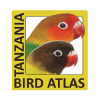
TANZANIA BIRD ATLAS
This monumental project (with almost 1.5 million records) uses crowd-sourced data collected over many decades to map bird distribution, month by month, for the whole of Tanzania.
We can contribute our bird records (including date and location) each month. Evidence of breeding is recorded too (e.g., plumage, courting, nests and eggs, or newly fledged young birds).
If you use the bird sightings app Birdlasser, you can export your bird records as a .CSV file, which will record date and GPS data automatically if you log the birds as you go. In the app settings, set taxon to IOC and First language to English (Tanzania).
Non-Birdlasser users can log sightings with the Excel recording sheet supplied.
![]()
Submit your .CSV Export file or excel recording sheet to:
mail <at> tanzaniabirdatlas.com or tzbirdatlas <at> yahoo.co.uk
The Atlas Project has a fantastic partner Facebook community at Birding Tanzania, where group members can share photos, find help identifying species, and peruse thousands of previous photos and in-depth ID discussions among world experts to learn from.
The result of this project is fantastic maps for every species, showing where we can find them and their movements month by month. The maps are scrupulously researched and include behaviour and habitat notes.
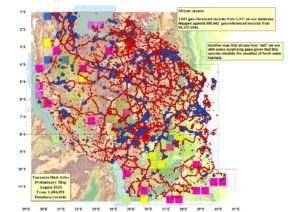
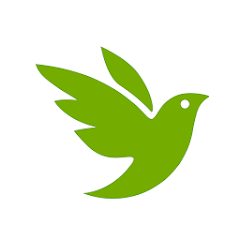
iNaturalist
iNaturalist is a global community where amateur and professional naturalists submit wildlife observations (with pictures, video or audio) for the community to verify species ID. After at least four people agree, an observation ID is classified “research grade” to avoid users being misled by tentative or optimistic identifications.
The resulting maps and guides let us identify wildlife hotspots to visit and learn what species live in our area. The global community of experts help us identify all the species we see, and we can help in return to corroborate or question others’ IDs.
Upload your observations or download the app:
At Zanzibar Wildlife we are exploring ways to tailor the iNaturalist experience to meet the needs of the Zanzibar wildlife community.
For the Bwawani Wetland please therefore explore the PLACE, PROJECT, CHECKLIST and GUIDE, and let us know what you think!
LATEST OBSERVATIONS LOGGED ON INATURALIST AT BWAWANI WETLAND
View more observations near Bwawani Wetland on iNaturalist » |

ebird
Developed by Cornell, ebird is probably the most widely used bird observation logging app.
Over 100 species have been recorded at Bwawani by ebird members – see the list here.
Download the eBird app:
WORKSHOPS & EXPERIENCES
Check out the Activities section for information about arranging a wader identification training workshop for your team or family.
© Nell Hamilton / Zanzibar Wildlife 2022
